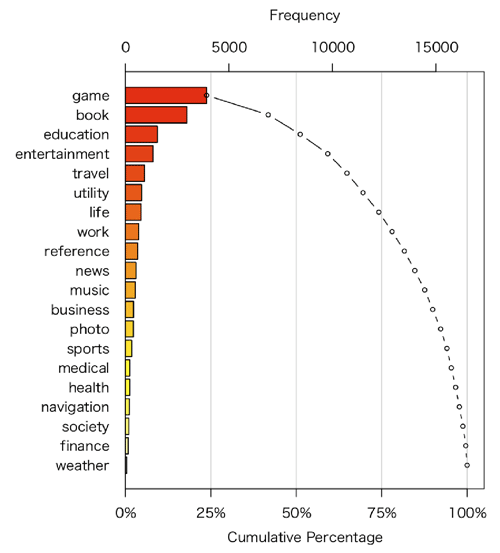Top>Opinion>Potential Uses of the iPad in Education and Research
 Index
Index

Toshinari Kamakura [Profile]
Potential Uses of the iPad in Education and Research
Toshinari Kamakura
Professor of Statistical Science, Social System Engineering, Faculty of Science and Engineering, Chuo University
When I got my iPad
May 31. Seeing me take my place at the podium with my newly-released iPad, the students reacted with oohs and aws. I started out by using it to convert my teaching materials to PDFs and as a presentation tool. The students were all surprised to see PowerPoint presentations being projected onto the screen from such a thin device.
But after a couple of classes, its novelty was lost and interest waned. Some students had become users with their own iPads, but when text materials intended for PC use are opened on an iPad, some are too large or much too complex, causing the iPad to hang. It may be necessary to keep the iPad in mind when developing new text materials.
What is it like for Science Courses?
Science courses require not only browsing the web or reading books, but also the preparation of technical documents (especially LaTeX), creating programs, numeric calculations, and simulations. Although the introduction of a different programming language to the iPad appears to be difficult, the problem can be solved by accessing the web server, having the main calculation performed by the server, and browsing the results on the iPad. In other words, the iPad only needs to provide server access and an application for the front end. The amount of software available for the iPad for this purpose is gradually increasing.
For example, programming language R, which I use for statistics education, can be used on the iPad using this method. The same applies to LaTeX. Not all iPad users will require this type of environment, but it is extremely favorable for science education and research. This can also be seen as a clouding of the calculation system. If one wants to use the iPad in a sophisticated manner, then the clouding of the data and calculation system is inevitable.
Apple's Strategy - Opening up Application Development
With the exception of the phone function, iPads and iPhones are merely nothing but little boxes without effective applications (hereinafter, "Apps"). By introducing various Apps, unlimited possibilities emerge. What is outstanding in Apple's strategy is the fact that they have made it possible for anybody to create programs, with only a few exceptions in the functions concerning the execution of the programming language.
As of June 7, 2010, there were 8,500 Apps for the iPad and 225,000 for the iPhone (including those in common with the iPad). It is said that there have been more than 35 million downloads, and it has been announced that a total of US$1 billion has been paid to developers. As of September 16, the former had grown to 16,500 titles and the latter had reached 249,000. When we consider the fact that the introduction of the iPad occurred on April 3, 2010 in the US and May 28, 2010 in Japan, the growth in the number of Apps in just three months is staggering.

Fig 1. Number of Apps by Category.
A system anyone can use
The first time I used a mobile phone, it was really surprising that I could talk with anyone by switching it on and punching in a phone number. When I first picked up the iPhone, that was what I originally thought would happen, but I had to complete an initial set-up even to get the phone to work, which was somewhat surprising in a different way. You also need to prepare a PC and internet connection before purchasing the iPhone. In order to introduce these devices into student training, it would be far better if they were much easier to use. Installing Apps basically occurs through iTunes. The transfer of presentation data files onto the iPad can only occur through iTunes, and furthermore, synchronization is limited to one specific iTunes application only (on one computer). Managing personally created data files through iTunes is over-management. It feels as if they're trying to push everything into iTunes. I really don't mind copyrighted data, such as music, being synchronized by a single mother ship, but there should be some ingenuity for presentation data and the like. Apple has made it possible to experimentally transfer one's own data to a specific application through a specific mail server, but the process is far from convenient. Of course, there are concerns regarding security and the protection of copyrights, but with the cloud being used for data these days, we would like to see a system where such an environment can be used freely.
An Educational and Research Environment Created by all Users
There are reports claiming that the iPad is mainly used for accessing the web and e-books. But this only indicates how it is being used, and not the necessity in education and research. In education and research use for science courses, the web and e-books are essential, but through the use of front end Apps and cloud computing, it is believed that a system of high usage value can be established. In addition, the Apps can be developed as students enjoy themselves, which should prove even more effective in terms of education. The iPad has significant potential for effective use as a portable terminal for gathering information and data suited to education and research, and I look forward to its further development.
Note) I have used data from http://catchapp.net/ for the price data for Apps mentioned in this paper. I hereby express my gratitude for the permission to do so.
- Toshinari Kamakura
Professor of Statistical Science, Social System Engineering, Faculty of Science and Engineering, Chuo University - Profile
Born in Nagano in 1953, Professor Kamakura graduated from the School of Engineering at Tokyo Institute of Technology in 1976. He received his Master's Degree from the Graduate School of Engineering at the Tokyo Institute of Technology in 1978. Professor Kamakura left school in 1980 during his PhD degree course at the Graduate School of Engineering, Tokyo Institute of Technology, and obtained his Doctorate in 1987 from the Tokyo Institute of Technology. After serving as a Researcher at the Institute of Statistical Mathematics, a full-time lecturer at the Ministry of Education, Science and Culture, and an Assistant Professor on the Faculty of Science and Engineering at Chuo University, Professor Kamakura took up his current position in 1995. His current research projects involve the analysis of reliability data and statistical methods and statistical evaluation methods in behavior recognition. - Professor Kamakura's primary works include: Data Science Nyuumon (co-author) (Suurikougaku-sha Co., Ltd., 2004), Tokei Data Kagaku Jiten (section author) (Asakura Publishing Co., Ltd., 2007), 21-Seikino Tokei Kagaku: Shizen, Seibutsu, Kenko no Tokeikagaku (section author) (Tokyo University Press, 2008), and Shika Rinsho Kenkyuuno Tokei Guide (overall supervising editor) (Ishiyaku Pub. Inc., 2009).
- Research Activities as a Member of Research Fellowship for Young Scientists (DC1), Japan Society for the Promotion of Science (JSPS) Shuma Tsurumi
- Important Factors for Innovation in Payment Services Nobuhiko Sugiura
- Beyond the Concepts of Fellow Citizens and Foreigners— To Achieve SDGs Goal 10 “Reduce Inequality Within and Among Countries” Rika Lee
- Diary of Struggles in Cambodia Fumie Fukuoka
- How Can We Measure Learning Ability?
—Analysis of a Competency Self-Assessment Questionnaire— Yu Saito / Yoko Neha - The Making of the Movie Kirakira Megane








